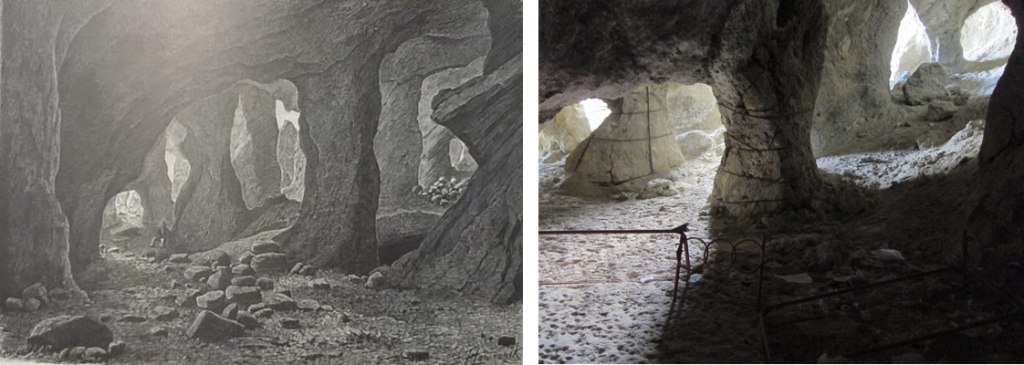Investigating 19th century Scottish industry abroad and within a European context using a Society grant
A collaborative project between the University of Glasgow, UK, the Sopratendenza di Messina, Sicily, Italy, CNR-ISMA, Rome, Italy and the Technical University of Crete, Greece
Effie Photos-Jones, Brian Barrett, Andrea di Renzoni and George Christidis
Funded by the Society of Antiquaries of Scotland with the assistance of the Wellcome Trust
About ‘Croesus’
James (‘Croesus’) Stevenson (1822-1903) was a Glasgow industrialist manufacturing sodium and potassium dichromates for the dyeing and calico industries. Sulphur (sulphuric acid) was a key ingredient in converting potassium chromate to potassium dichromate (McLean 1901). At the time it was usual to import raw sulphur from the Mediterranean and in the 1870’s Stevenson, taking advantage of the political upheavals in Italy bought, from the departing Bourbons, the sulphur-rich volcanic island of Vulcano in the Aeolian Islands. He extracted and successfully processed sulphur but other minerals as well.
Stevenson was an astute businessman, a keen yatchman and a philanthropist. He bequeathed his collection of Lipari antiquities to Glasgow’s Kelvingrove Museum. In Vulcano he built the ‘casa dell’Inglese’ in Scottish pseudo-baronial style which survives to this day. He never married and lived with his father until the latter’s death. At the time of his coming to the inheritance of his father’s cotton fortune he was 47, single, handsome and rich. According to his family’s biographer ‘..he was canny with his money, but could be generous to a fault. He would lavish hospitality on his relations, but was shy and retiring at the same time. In public life he would sometimes find himself in the limelight- perhaps even courted it- but then, inexplicably, would shrink from it’. He was a ‘hypochondriac’ afraid to exert himself but in actual fact quite healthy (Stevenson 2009, 164).

Left: Crater of Vulcano by J Houel, Hermitage Museum. Houel travelled to Sicily and the Aeolian islands between 1776 and 1779. Right: picture of the crater – 30th November 2016, looking towards the north. Assent on the crater is not difficult and as Smythe (1824) noted ‘even an invalid can climb it’. However the active fumaroles on the top create an intensely toxic environment. Lipari island is visible beyond the crater in the distance and also the twin peaks of Salina (called Didyme, by the Greeks). © The Vulcano Project
About ‘this project’
This project examines 19th century Scottish industry abroad and within a European context. The project forms the continuation of our investigation into medicinal minerals of the Greco-Roman world currently the focus of a Wellcome Trust Seed award (http://www.gra-ams.com/). It is almost certain that Stevenson relied for the recovery of particular minerals and energy resources on well-tried and tested processes, probably set in place since antiquity. As a result, Stevenson’s extractive practices and installations at Vulcano have the potential to shed light on similar techniques used in antiquity, in the Aeolians and beyond. There has been no proper archaeological survey of the island and this project offers a unique opportunity to examine the island closely. Stevenson’s activities included extraction of sulphur from within the crater (see Fig. above).
This is a complex and fascinating story potentially offering a rarely accessed penetrating insight into particular individuals, attitudes and time-old (industrial) practices. It is also very much a multi-disciplinary project following in the footsteps of our on-going work (geo-archaeological surveys) in the Aeolian and the Aegean Islands employing a multitude of scientific techniques (Photos-Jones and Hall 2011; Photos-Jones et al 2016). The project explores local vs global industrial relationships across the ages and the cross-linking of industrial expertise albeit, in a largely pre- industrial context.

Archduke’s Louis Salvator depiction of the interior of the alum mine/cave in Vulcano, shortly after the closure of all works following the volcanic eruption of August 3rd, 1888. Picture on the right was taken from within the alum cave on December 1st 2016. © The Vulcano Project.
As part of this first phase of work we established (a) the locations of sulphur and alum extraction, in the crater /solfatara and the alum cave respectively (see Fig. above), b) the area of the workshops and c) the calcarone furnaces for sulphur extraction on the volcano’s eastern slope; (d) we identified potentially earlier (Roman?) activities in the area of the Faraglione, and (e) we sampled extensively geological specimens from the area of the Faraglione and the alum cave, the crater and the calcarone. 3D capture technologies have been applied to a number of these sites with the intention of providing 3D models for exploration in a virtual archive. These will act as a contemporary baseline and allow for further investigation into these areas in the future.
References
Archduke Ludwig Salvator 1893. Die Liparischen Inseln. Volume I : Vulcano. prag: druck und Verlag von Heinr Mercy.
McLean, A, 1901. Local Industries of Glasgow and the West of Scotland. British Association for The Advancement Of Science.
Photos-Jones, E. and Hall, A. J. 2011. Lemnian Earth and the earths of the Aegean: an archaeological guide to medicines, pigments and washing powders, Glasgow: Potingair Press
Photos-Jones, E, G.E. Christidis, M. Piochi, C. Keane, A.Mormone, G. Balassone,V. Perdikatsis and , A. Leanord 2016. Testing Greco-Roman medicinal minerals: The case of solfataric alum. Journal of Archaeological Science: Reports 10, 82–95.
Stevenson H, 2009 Jobs for the Boys London: Dove Books.
Help us: champion research; stimulate discussion; enhance public understanding; and share our extraordinary heritage. Donate directly to the Society now.